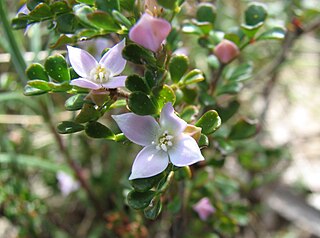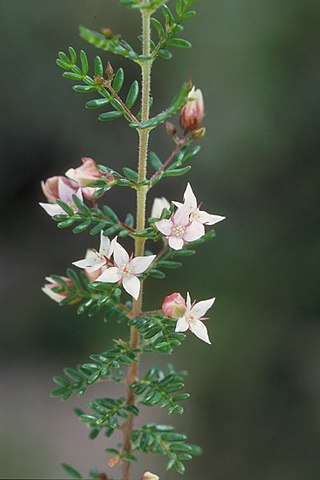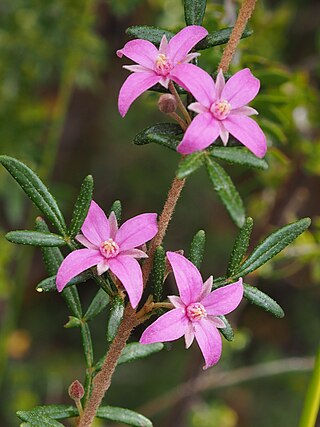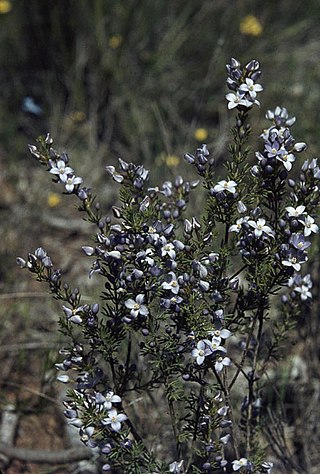
Boronia pinnata is a plant in the citrus family, Rutaceae, and is endemic to New South Wales. It is an erect, woody shrub with pinnate leaves and groups of between three and forty pink flowers arranged in leaf axils. It flowers in spring and early summer and is found in coastal areas between Ballina and Jervis Bay.

Boronia algida, commonly known as alpine boronia, is a flowering plant in the citrus family, Rutaceae and is endemic to south-eastern Australia. It is an erect shrub with many branches, pinnate leaves and white to bright pink, four-petalled flowers usually borne singly on the ends of branches.

Boronia safrolifera, commonly known as safrole boronia, is a species of flowering plant that is endemic to eastern Australia. It is an erect, woody shrub with pinnate leaves that have up to nineteen leaflets, and white to pink, four-petalled flowers.

Cyanothamnus anemonifolius, commonly known as narrow-leaved boronia or sticky boronia, is a flowering plant that is endemic to south-eastern Australia. It is a shrub with mostly pinnate leaves, with white to pale pink four-petalled flowers in leaf axils.

Boronia alulata is a plant in the citrus family, Rutaceae and is endemic to Cape York Peninsula. It is an erect shrub with many branches, pinnate leaves and pink or white, four-petalled flowers.

Boronia falcifolia, commonly known as the wallum boronia, is a plant in the citrus family, Rutaceae and is endemic to near-coastal areas of eastern Australia. It is a shrub with only a few stems, usually three-part leaves and bright pink, four-petalled flowers.

Cyanothamnus rigenss, commonly known as the stiff boronia, is a plant in the citrus family Rutaceae and is endemic to south-eastern New South Wales in Australia. It is a low, compact shrub with mostly trifoliate, glandular leaves and white to pale pink, four-petalled flowers in the leaf axils.

Boronia warrumbunglensis is a plant in the citrus family Rutaceae and is endemic to a small area in the central west of New South Wales. It is a shrub with many branches, pinnate leaves and one or two pink, four-petalled flowers in the leaf axils. It is only known from the Warrumbungles and nearby districts.
Boronia citrata, commonly known as lemon boronia, is a plant in the citrus family, Rutaceae and is endemic to Victoria. It is an erect, woody shrub with pinnate, strongly lemon-scented leaves and pale pink to rosy pink, four-petalled flowers arranged in groups of up to five.

Boronia filicifolia is a plant in the citrus family, Rutaceae and is endemic to the far north-west of Australia. It is an erect or sprawling shrub with many branches, pinnate leaves with up to 55 leaflets and white to pink flowers with the sepals a similar length to the petals.

Cyanothamnus inconspicuus is a plant in the citrus family, Rutaceae and is endemic to the south-west of Western Australia. It is a shrub with pinnate leaves and small white or creamy green flowers with four petals and eight stamens and occurs from the Stirling Range to Mount Ragged.

Cyanothamnus inflexus is a plant in the citrus family Rutaceae and is endemic to tablelands near the New South Wales - Queensland border in Australia. It is an erect, woody shrub with pinnate leaves and up to seven white to pink four-petalled flowers in the leaf axils. Boronia bipinnata is similar but has larger, bipinnate or tripinnate leaves and smaller sepals and petals.
Boronia minutipinna is a plant in the citrus family Rutaceae and is endemic to a small area in the Kimberley region of Western Australia. It is an erect shrub with many branches, hairy stems and leaves, pinnate leaves and white to pink, four-petalled flowers with the sepals longer and wider than the petals.
Cyanothamnus montimulliganensis is a plant in the citrus family Rutaceae and is endemic to a single mountain in Queensland. It is an erect, woody shrub with pinnate or bipinnate leaves and white, four-petalled flowers usually arranged singly in leaf axils.

Cyanothamnus penicillatus is a plant in the citrus family, Rutaceae and is endemic to the south-west of Western Australia. It is a low, spreading shrub with pinnate leaves and white flowers with four petals and eight stamens.

Cyanothamnus polygalifolius, commonly known as dwarf boronia, milkwort-leaved boronia or milkwort boronia, is a plant in the citrus family Rutaceae and is endemic to eastern Australia. It is a low-lying shrub with simple leaves and white or pink flowers arranged singly or in groups of up to three in leaf axils.

Cyanothamnus ramosus is a species of plant in the citrus family Rutaceae and is endemic to the southwest of Western Australia. It is an erect, mostly glabrous shrub with pinnate leaves with up to seven leaflets, and white, four-petalled flowers with blue or pale green backs.

Boronia tolerans is a plant in the citrus family, Rutaceae and is endemic to a small area in the Northern Territory in Australia. It is an erect shrub with many branches, pinnate leaves and white, four-petalled flowers. It is only known from Nitmiluk National Park.

Boronia wilsonii is an erect shrub that is endemic to northern Australia. Its branches, leaves and backs of the flowers are densely covered with woolly hairs. The petals are white to pink or burgundy-coloured.
Cyanothamnus yarrowmerensis is a species of erect, woody shrub that is endemic to Queensland. It has pinnate or bipinnate leaves and groups of up to seven flowers with white petals in leaf axils.


















